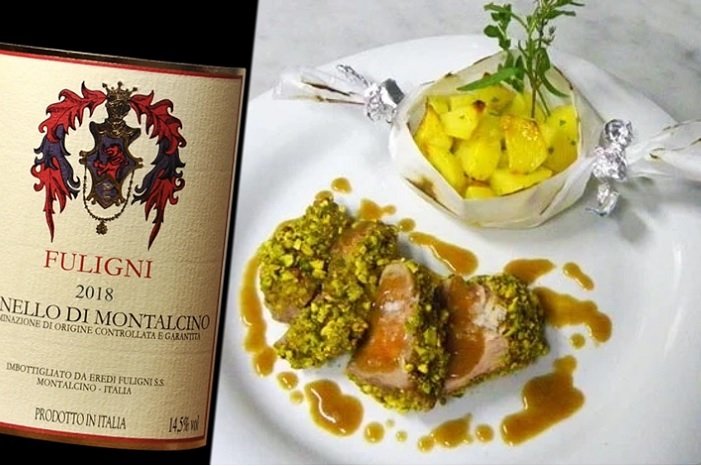For this dish I was inspired by Chef Giovanni Santoro's recipe from Shalai Resort in Linguaglossa (Ct), which called for a crust with pistachios and almonds and a Marsala cream. I preferred a Brunello sauce to go with the excellent Brunello di Montalcino 2018 Fuligni.
Ingredients for 4 persons:
4 slices of pork tenderloin 150 g each, 1 tablespoon of evo oil, 1 clove of garlic, 2 bay leaves, 1 sprig of rosemary, flour 00 to taste, salt and pepper to taste, 8 slices of lard, 2 egg whites
For the dried fruit breadcrumbs:
200 gr. breadcrumbs, 100 gr. pine nuts, 100 gr. hazelnuts
For the Brunello sauce:
2 glasses of Brunello di Montalcino, 1 tablespoon butter, 1 clove garlic, 2 bay leaves, 2 teaspoons potato starch, salt to taste.
Procedure:
Brown the previously floured pork tenderloins in a pan with oil, garlic, bay leaf and rosemary. Place in a dish and allow to cool.
Meanwhile, prepare the dried fruit panure by putting pine nuts and hazelnuts in the blender. Add breadcrumbs and adjust salt and pepper.
As soon as the fillets are cold, coat each one with 2 slices of lard. Then brush with egg white and bread them generously in the dried fruit panure.
Bake in a 190° oven for about 10 minutes. The meat should not be overcooked, to also prevent it from becoming too dry. Therefore, allow at least the heart of the fillet to be pink.
Place butter, garlic and bay leaves in a saucepan. Then add the Brunello and bring to a boil, waiting for it to reduce a little. Dissolve the starch in cold water and add it to the Brunello. Continue simmering for a few more minutes and strain.
Sprinkle the fillets with a few spoonfuls of Brunello sauce.
Serve with baked potatoes or other side dish as desired.
 Wine pairing:
Wine pairing:
Brunello di Montalcino 2018 Fuligni
Brilliant ruby of medium density. Nose on fresh fruit notes, white peach, tart cherry and a touch of green spices. Elegant, agile texture, excellent very composed tannins and beautifully crafted and balanced progression. Savory, vertical and persistent finish.
Production area: vineyards located partly in the northeastern part of the Montalcino hillside. Other vineyards were planted in east-south exposure, in mixed tuff and clay soils.
Grape varieties: 100% Sangiovese. Average age of vineyards around 20 years with some plantings over 40 years old, bearing old estate clones. Horizontal spurred cordon (bilateral) training system with a density ranging from 3,333 to 5,600 vines per hectare. Average yield per hectare not exceeding 50 quintals of grapes.
Harvest:
harvesting is done by hand in late September, with the personal participation of the owners in order to ensure strict selection of the grapes, with subsequent passes between the rows and final selection plate.
Production processes: the various estate vineyards (S. Giovanni, Il Piano, Il Ginestreto, La Bandita, S. Luigi, Matilde, Margherita, Poggi I, II and III) are vinified separately by soil type and exposure, and then blended. Vinification takes place in stainless steel vessels with a capacity not exceeding 60 hl, with temperature control. Fermentation is followed by a variable period of time on the skins, and malolactic fermentation takes place immediately thereafter.
Refinement: takes place for about ¼ in Allier tonneaux of 5 hl. capacity, for the main purpose of obtaining adequate anthocyanin fixation. The remaining ¾ of the mass is matured in traditional Slavonian oak barrels of 20 and 30 hl. capacity, partly still located in the ancient cellar located under the 16th-century Medici palace, still the residence of the Fuligni family. This is followed by further aging in stainless steel and, for about 8 months, in the bottle, before marketing.
Serving temperature: 16-18°C.
Recommended pairings: goes well with rich and structured dishes, such as red meat, game, and aged cheeses.





